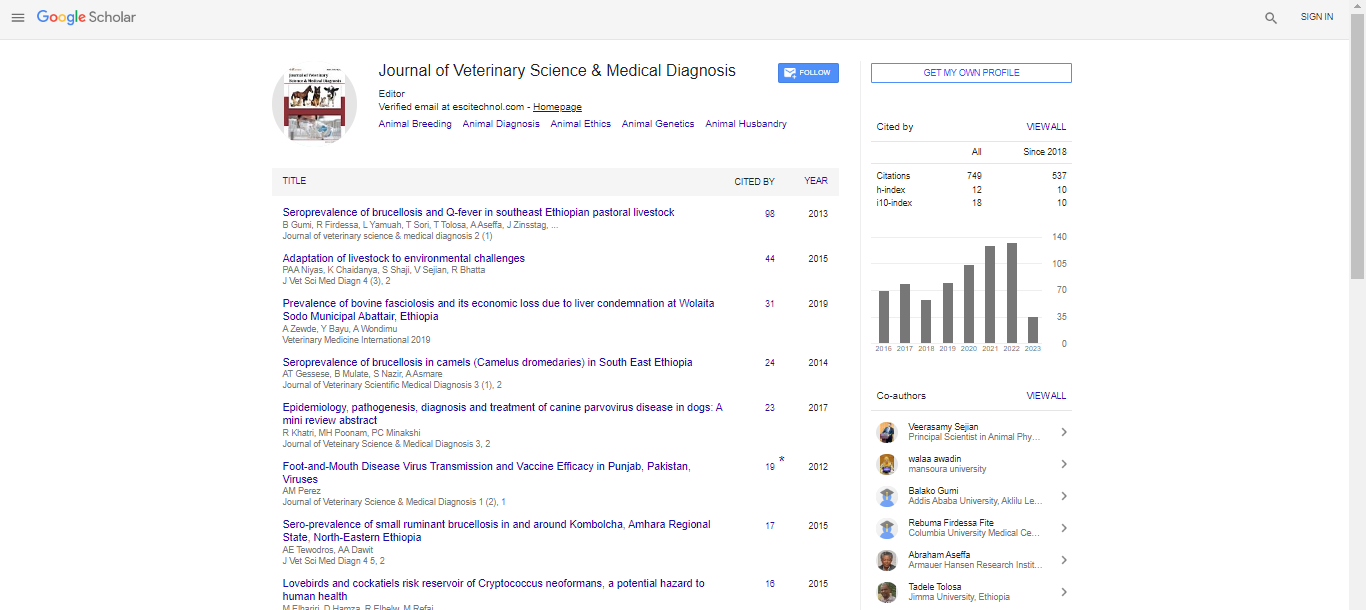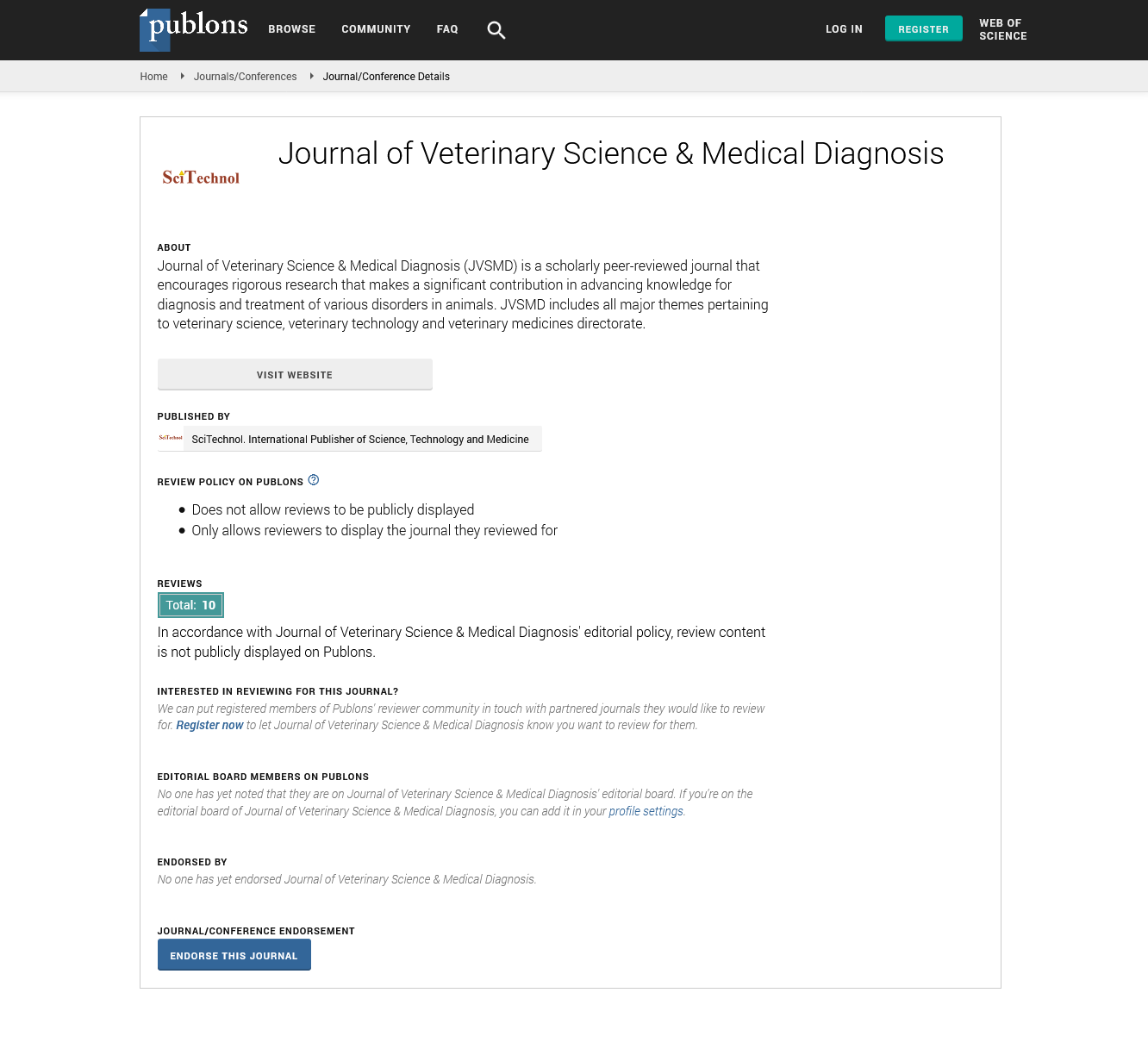Opinion Article, J Vet Sci Med Diagn Vol: 12 Issue: 3
Overview of Various Respiratory Diseases in Live Stock
Peter Drucker*
1Division of veterinary pathology, Nossal Institute for Global Health, Melbourne, Australia
*Corresponding Author: Peter Drucker,
Division of veterinary pathology, Nossal
Institute for Global Health, Melbourne, Australia
E-mail: peter@micbio.au
Received date: 27 April, 2023, Manuscript No. JVSMD-23-102098;
Editor assigned date: 01 May, 2023, Pre QC No. JVSMD-23-102098 (PQ);
Reviewed date: 15 May, 2023, QC No. JVSMD-23-102098;
Revised date: 22 May, 2023, Manuscript No: JVSMD-23-102098(R);
Published date: 29 May, 2023, DOI: 10.35248/2325-9590.23.12.100055.
Citation: Drucker P (2023) Overview of Various Respiratory Diseases in Live Stock. J Vet Sci Med Diagn 12:3.
Keywords: Respiratory Diseases
Description
Respiratory diseases pose a significant threat to the health and productivity of livestock animals worldwide. These diseases, affecting animals such as cattle, pigs, and poultry, can have severe economic consequences for farmers and the agricultural industry. Understanding the causes, symptoms, prevention, and management of respiratory diseases in livestock is crucial for ensuring the welfare of animals, maintaining production efficiency, and safeguarding public health.
Respiratory diseases in livestock can result in substantial economic losses due to reduced productivity, increased mortality rates, and the need for expensive treatments. These diseases often lead to weight loss, reduced feed efficiency, and impaired reproduction, affecting overall farm profitability. Additionally, infected animals may require prolonged recovery periods, leading to delayed market readiness and increased costs for farmers. Furthermore, these can have implications for public health, as certain pathogens can be transmitted from animals to humans, causing zoonotic infections. These diseases can be caused by a variety of factors including infectious agents, environmental stressors, poor ventilation, and inadequate biosecurity measures. Common pathogens associated with respiratory diseases in livestock include bacteria such as Mannheimia haemolytica, Pasteurella multocida as well as viruses like Bovine Respiratory Syncytial Virus (BRSV), Porcine Reproductive and Respiratory Syndrome Virus (PRRSV), and avian influenza virus.
Prevention is key in decreasing respiratory diseases in livestock. Implementing proper biosecurity measures is essential to reduce the risk of disease introduction and transmission. This includes controlling animal movements, restricting visitors, and disinfecting equipment and facilities. Adequate ventilation and air quality management in barns and housing systems can also help minimize the spread of respiratory pathogens. Vaccination programs should be done against specific pathogens can provide protective immunity and reduce the severity of respiratory diseases. Regular monitoring and surveillance of livestock populations can aid in early detection and prompt intervention.
Effective management of respiratory diseases requires education and training for livestock farmers and workers. They need to be aware of the signs and symptoms of respiratory diseases, as early detection can help prevent further spread. Training programs can provide knowledge on proper hygiene practices, biosecurity measures, and vaccination protocols. Collaborations between veterinary professionals extension services, and farmer’s organizations can facilitate dissemination dissemination of information and promote best practices in respiratory disease prevention and management.
Common Respiratory Diseases in livestock includes Bovine Respiratory Disease (BRD), also known as shipping fever pneumonia, is a complex and multifactorial respiratory condition primarily affecting cattle. It is caused by a combination of viral and bacterial pathogens, environmental stressors, and management factors. Common pathogens involved include bovine herpesvirus, bovine viral diarrhea virus, and various bacteria. BRD can result in significant economic losses due to decreased weight gain, reduced milk production, and treatment costs. Porcine Respiratory Disease Complex (PRDC) is a complex respiratory disease affecting pigs, typically caused by a combination of viral and bacterial infections. The key pathogens involved include porcine reproductive and respiratory syndrome virus, swine influenza virus, porcine circovirus, and various bacteria like Actinobacillus pleuropneumoniae and Mycoplasma hyopneumoniae. PRDC leads to decreased growth rates, increased mortality, and a higher risk of secondary infections, contributing to substantial economic losses in the swine industry. Ovine Respiratory Complex (ORC) encompasses a range of respiratory diseases affecting sheep, including bacterial and viral pneumonia, enzootic nasal tumor, and parasitic infections. Mannheimia haemolytica and Pasteurella multocida are common bacterial pathogens associated with ORC, while respiratory syncytial virus and adenovirus play a significant role in viral pneumonia. ORC can cause severe respiratory distress, reduced productivity, and increased mortality rates in sheep flocks.
 Spanish
Spanish  Chinese
Chinese  Russian
Russian  German
German  French
French  Japanese
Japanese  Portuguese
Portuguese  Hindi
Hindi 
